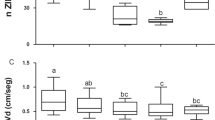Abstract
Two bacterial strains, 4:44 and PB52, isolated from turbot(Scophthalmus maximus L.) were used during a first feedingexperiment with turbot larvae. Bacteria were either added directly tothe water on the day of hatching of the larvae (day 0), orbioencapsulated in rotifers (Brachionus plicatilis) distributedon day 2 after hatching. The two bacterial strains were found to bepresent in the water of the rearing tanks throughout the experiment. Theaddition of bacteria influenced the species-composition of themicroflora associated with intensively produced rotifers added to thetanks, and resulted in colonization of the gut of the larvae by theadded bacterial strains. The strain 4:44 showed a peak on day 9 afterhatching, and reached a mean(sem) of 2.5(1.4) × 104bacteria per larva, when added in a mixture with PB52, and 0.4(0.1)× 104 bacteria per larva, when added alone. The strainPB52, on day 12 after hatching, reached 5.2(1.5) × 104bacteria per larva when added in a mixture with strain 4:44, and12.5(0.7) × 104 bacteria per larva, when added alone.The added bacteria colonized the gut turbot larvae, whereas thebacterial land, the survival and growth of the larvae were in most casesnot influenced in a negative way by the addition of bacteria.
Similar content being viewed by others
References
Adams, A. (1991) Detection of Vibrio parahaemolyticusbiotype alginolyticusin penaid shrimp using an amplified enzyme-linked immunosorbent assay. Aquaculture 93, 101–108.
Ey, P.L., Prowse, S.J. and Jenkin, C.R. (1978) Isolation of pure IgG1, IgG2aand IgG2bimmunoglobulins from mouse serum using protein A-sepharose. Immunochemistry 15, 4290-436.
Gatesoupe, F.J. (1994) Lactic acid bacteria increase the resistance of turbot larvae, Scophthalmus maximus, against a pathogenic Vibrio. Aquatic Living Resources 7, 277–282.
Guillard, R.R.L. (1975) Culture of phytoplankton for feeding marine invertebrates. In: Culture of Marine Invertebrate Animals(eds. W.L. Smith and M.H. Chanley). Plenum Publishing Corporation, New York, pp. 29–60.
Hansen, G.H. and Olafsen, J. (1989) Bacterial colonization of cod (Gadus morhuaL.) and halibut (Hippoglossus hippoglossus) eggs in marine aquaculture. Applied and Environmental Microbiology 55, 1435–1446.
Hansen, G.H. and Olafsen, J. (1999) Bacterial interactions in early life stages of marine cold water fish. Microbial Ecology 38, 1- 26.
Hobbie, J.E., Daley, R.J. and Jasper, S. (1977) Use of nuclepore filters for counting bacteria by fluorescence microscopy. Applied Environmental Microbiology 33, 1225–1228.
Kawai, K., Yamamoto, S. and Yasuda, R. (1989) Plankton-mediated delivery of Vibrio anguillarumvaccine to juvenile Ayu. Nippon Suisan Gakkaishi 55, 35–40.
Kotani, H. and McGarrity, G.J. (1986) Identification of mycoplasma colonies by immunobinding. Journal of Clinical Microbiology 23, 783–785.
Makridis, P., Fjellheim, A.J., Skjermo, J. and Vadstein, O. (2000) Control of the bacterial flora of Brachionus plicatilisand Artemia franciscanaby incubation in bacterial suspensions. Aquaculture 185, 207–216.
Munro, P.D., Barbour, A. and Birkbeck, T.H. (1994) Comparison of the gut bacterial-flora of start-feeding larval turbot reared under different conditions. Journal of Applied Microbiology 77, 560-566.
Munro, P.D., Barbour, A. and Birkbeck, T.H. (1995) Comparison of the growth and survival of larval turbot in the absence of culturable bacteria with those in the presence of Vibrio anguillarum, Vibrio alginolyticus, or a marine Aeromonassp. Applied and Environmental Microbiology 61, 4425–4428.
Munro, P.D., Henderson, R.J., Barbour, A. and Birkbeck, T.H. (1999) Partial decontamination of rotifers with ultraviolet radiation: the effect of changes in the bacterial load and flora of rotifers on mortalities in start-feeding larval turbot. Aquaculture 170, 229–244.
Nicolas, J.L., Robic, E. and Ansquer, D. (1989) Bacterial flora associated with a trophic chain consisting of microalgae, rotifers, and turbot larvae: influence of bacteria on larval survival. Aquaculture 83, 237–248.
Olafsen, J.A. and Hansen G.H. (1992) Intact antigen uptake in intestinal epithelial cells of marine fish larvae. Journal of Fish Biology 40, 141–156.
Olsen, Y., Reitan, K.I. and Vadstein, O. (1993) Dependence of temperature on loss rates of rotifers, lipids, and !3 fatty acids in starved Brachionus plicatiliscultures. Hydrobiologia 255/256, 13–20.
Olsson, J.C., Westerdahl, A., Conway, P.L. and Kjelleberg, S. (1992) Intestinal colonization potential of turbot (Scophthalmus maximus) - and dab (Limanda limanda) - associated bacteria with inhibitory effects against Vibrio anguillarum. Applied and Environmental Microbiology 58, 551–556.
Perez-Benavente, G. and Gatesoupe, F.J. (1988) Bacteria associated with cultures rotifers and Artemia are detrimental to larval turbot. Aquacultural Engineering 7, 289–293.
Reitan, K.I., Rainuzzo, J.R., Øie, G. and Olsen, Y. (1993) Nutritional effects of algal addition in first-feeding of turbot (Scophthalmus maximusL.) larvae. Aquaculture 118, 257–275.
Reitan, K.I., Natvik, C.M. and Vadstein, O. (1998) Drinking rate, uptake and microalgae in turbot larvae. Journal of Fish Biology 53, 1145–1154.
Ringø, E., Birkbeck, T.H., Munro, P.D., Vadstein, O. and Hjelmeland, K. (1996) The effect of early exposure to Vibrio pelagiuson the aerobic flora of turbot, Scophthalmus maximus(L.) larvae. Journal of Applied Bacteriology 81, 207–211.
Ringø, E. and Birkbeck, T.H. (1999) Intestinal microflora of fish larvae and fry. Aquaculture Research 30, 73–93.
Salvesen, I., Skjermo, J. and Vadstein, O. (1999) Growth of turbot (Scophthalmus maximus L.) during first feeding in relation to the proportion of r/K-strategists in the bacterial community of the rearing water. Aquaculture 175, 337–350.
Skjermo, J. and Vadstein, O. (1993) Characterization of the bacterial flora of mass cultivated Brachionus plicatilis. Hydrobiologia 255/256, 185–191.
Skjermo, J., Salvesen, I., Øie, G., Olsen, Y. and Vadstein, O. (1997) Microbially matured water: a technique for selection of a non-opportunistic bacterial flora in water that may improve performance of marine larvae. Aquaculture International 5, 13–28.
Zar, J.H. (1996) Biostatistical Analysis. Prentice-Hall International, Inc., Upper Saddle River, USA.
Øie, G., Makridis, P., Reitan, K.I. and Olsen, Y. (1997) Protein and carbon utilization of rotifers (Brachionus plicatilis) in first feeding of turbot larvae (Scophthalmus maximusL.). Aquaculture 153, 103–122.
Author information
Authors and Affiliations
Corresponding author
Rights and permissions
About this article
Cite this article
Makridis, P., Jon Fjellheim, A., Skjermo, J. et al. Colonization of the gut in first feeding turbot by bacterial strains added to the water or bioencapsulated in rotifers. Aquaculture International 8, 367–380 (2000). https://doi.org/10.1023/A:1009251531832
Issue Date:
DOI: https://doi.org/10.1023/A:1009251531832



